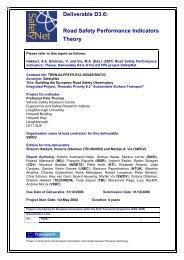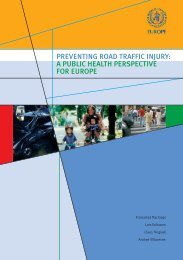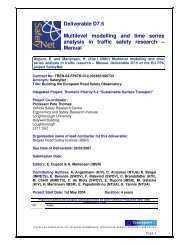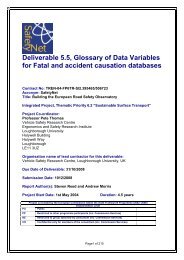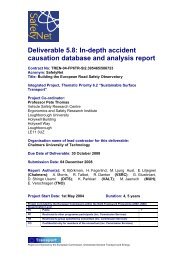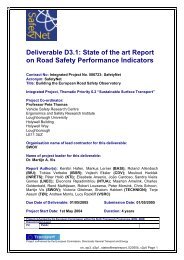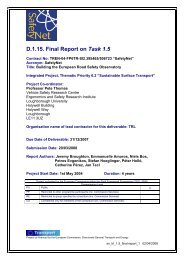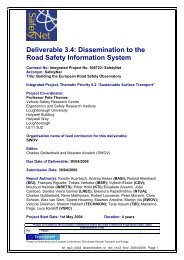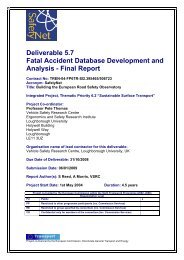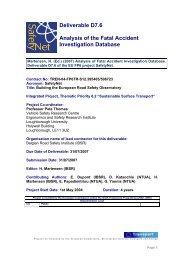Every Accident is One Too Many Every Accident is One ... - UNECE
Every Accident is One Too Many Every Accident is One ... - UNECE
Every Accident is One Too Many Every Accident is One ... - UNECE
You also want an ePaper? Increase the reach of your titles
YUMPU automatically turns print PDFs into web optimized ePapers that Google loves.
Appendix<br />
26. Development and demonstration projects on telematics<br />
27. International requirements on vehicle design and equipment as regards telematics and road safety<br />
28. <strong>Accident</strong> stat<strong>is</strong>tics must be more detailed<br />
29. Collect experience on coordination of hospital data and accident records from the police<br />
30. Trial projects on systematic collection and communication of hospital data on road accidents<br />
31. Evaluate Dan<strong>is</strong>h road safety efforts from 1988 to 2000<br />
32. Automated speed checking must be introduced all over Denmark if the trial project yields positive results<br />
33. Funding of local road safety efforts via fines from automated speed checks<br />
34. County/municipal speed plans<br />
35. Speed limits on low-standard primary roads<br />
36. Speed differentiation in urban areas<br />
37. Restructuring of urban thoroughfares<br />
38. Dynamic speedometers<br />
39. Intensified police efforts directed against 30 - 50 year old drivers under the influence of alcohol - particularly during<br />
the summer half<br />
40. ‘Say No’ campaigns aimed at young drivers in all counties<br />
41. Special efforts aimed at drivers who are repeatedly apprehended for drink-driving, including trial projects on car<br />
immobil<strong>is</strong>ers to be deactivated by successful breathalyser testing<br />
42. Extended supplementary training for drivers whose driving licence <strong>is</strong> suspended due to drink-driving<br />
43. Efforts directed against drugs in traffic<br />
44. Greater segregation of traffic in urban areas<br />
45. Improved opportunities for crossing roads for pedestrians<br />
46. Interconnected route network for cycl<strong>is</strong>ts<br />
47. Restructuring of road junctions<br />
48. Maintenance of cycling paths<br />
49. New requirements for vehicles, including new front-end designs to reduce injuries to ‘soft’ road users if hit<br />
50. Campaigns for greater cycling-helmet usage<br />
51. Minimum standards for bicycle lights<br />
52. Consider whether compulsory fixed bicycle lights would improve road safety<br />
53. Cycl<strong>is</strong>ts’ safety must be included in local-authority planning<br />
54. Serious safety <strong>is</strong>sues and potential improvements regarding road junctions must be identified<br />
55. Automated checkpoints directed against drivers who jump red lights if the trial project yields positive results<br />
56. Continued establ<strong>is</strong>hment of roundabouts at dangerous road junctions<br />
57. Speed limits at road junctions on primary roads<br />
58. Stop signs at road junctions without traffic lights where many accidents occur due to failure to observe one’s duty<br />
to give way to approaching traffic<br />
59. Modern<strong>is</strong>ation of road junctions with traffic lights, e.g. through greater signal v<strong>is</strong>ibility<br />
60. Systematic identification of black spots<br />
61. More research and development<br />
62. An <strong>Accident</strong> Investigation Board for road accidents<br />
45



